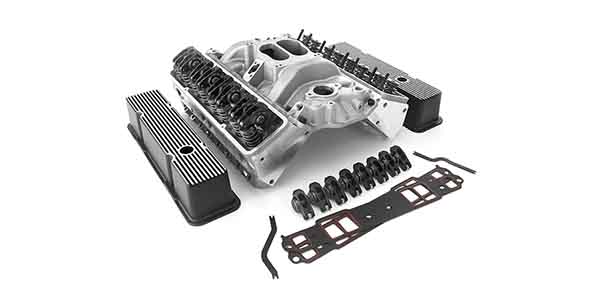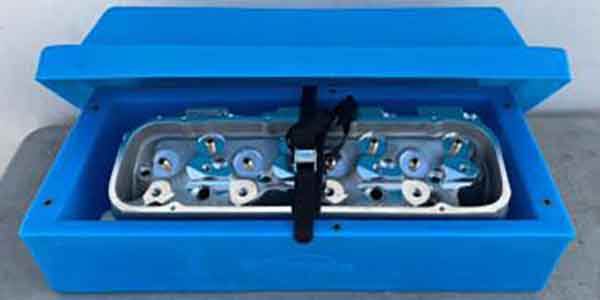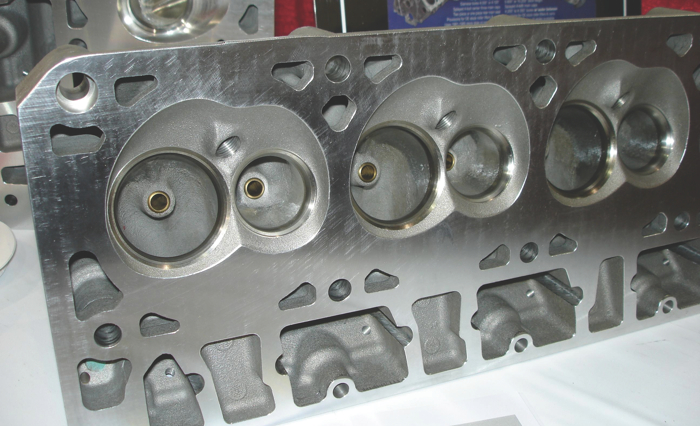
Choosing the “right” cylinder heads for an engine build can make all the difference in an engine that delivers and one that falls short of its potential. Horsepower, torque and throttle response all depend on how well the cylinder heads, camshaft and induction system work together. Choose the right combination and you’ll build a winner. Choose the wrong combination and you’ll end up with a mismatch that never achieves what you set out to achieve.
Choosing a set of aftermarket performance cylinder heads is not as simple as it sounds because there are so many different heads from which to choose. Comparing heads from various suppliers isn’t exactly a straight-forward process because numbers can be very misleading.
One thing is certain. There is way too much emphasis on peak airflow numbers. “The first thing a customer usually asks when they call about a set of heads is how much air do they flow? Or what’s the port volume? None of these numbers will tell you how much horsepower a set of heads will actually make because the power output depends on the combination of parts in the motor and the application,” said one head supplier.
Don’t Overdo It!
The one thing every head supplier cautions against is putting too much head on an engine that can’t handle it. Just like too much carburetion or too much cam duration, the heads, cam and induction system (and exhaust system too) all have to work together to produce the best possible results.
The common assumption (which is often a misconception) is that a set of heads that has the highest airflow numbers will always make the most power. They will under the right circumstances, if the engine can take full advantage of the flow potential of the heads. But often the tendency is to go with heads that are too large for a given application, which ends up hurting performance more than it helps.
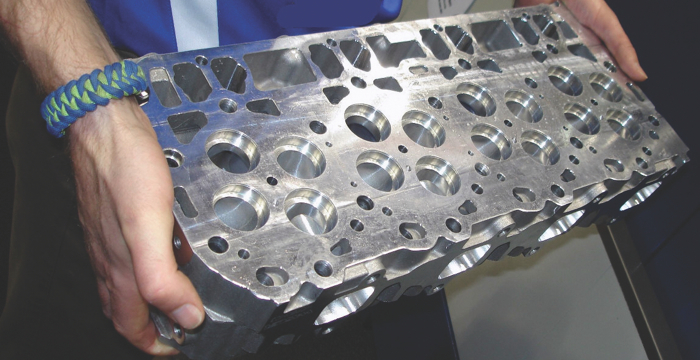
For example, a street performance 350 Chevy with a hydraulic cam will never pull as much air as many race heads can deliver. Race heads are designed with larger port volumes and bigger valves so they can handle more airflow for large displacement stroker engines and/or high revving drag or circle track engines with long duration, high-lift cams. Bolt a set of race heads on an otherwise stock 350 in a street car and you’ll end up with a dog that has no throttle response or low to mid-range torque. The heads need to be sized to the application.
On the other hand, if you’re building a large displacement stroker motor, you’ll need heads with larger ports to handle the increased air volume the engine requires. A set of heads with 185cc ports would deliver the best all-round performance for a 350 CID engine, while a set of heads with 200cc to 220cc ports would work better on a 383 to 400 stroker. The larger the displacement of the engine, the larger the port volume the heads need to deliver the airflow. Ditto for a high revving race engine with a lot of cam lift and duration.
Airflow Numbers
Airflow is measured in cubic feet per minute (CFM) on an airflow bench. Typically, airflow is measured in 0.10˝ valve opening increments from about 0.200˝ of lift to peak valve lift. For stock heads and most street heads, peak valve lift is going to be 0.500˝ to maybe 0.650˝ with high-lift rockers, so measuring airflow beyond peak valve lift for these kind of applications is meaningless. Yet the peak airflow numbers advertised for some heads are at much larger valve lifts (up to one inch). If you’re building a ProStock drag motor that’s going to rev over 11,000 RPM with over one inch valve lift, then peak airflow numbers at one inch of valve lift is important. Otherwise it doesn’t matter.
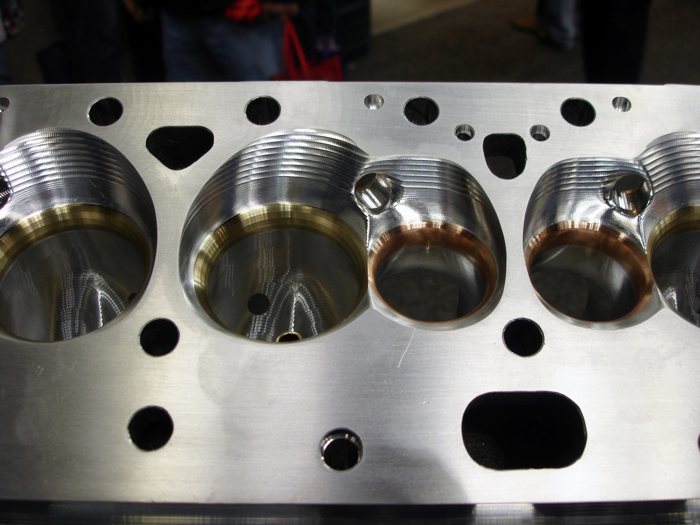
Most head suppliers say the airflow numbers that count the most for street performance are those from about 0.200˝ to 0.500˝ of valve lift. A head that delivers the most airflow within this range will often outperform a head that has higher peak airflow numbers at 0.500˝ of valve lift and above. Why? Because peak airflow only happens at one point in the valve lift cycle (when the valve is fully open) whereas airflow that occurs when the valve is half open happens twice every valve cycle. Consequently, if a head flows well at part valve lift, it will do a better job of maintaining high air velocity for more power, torque and throttle response.
What about a set of heads that have great peak airflow numbers when the valves are at maximum lift but maybe not so great numbers at part valve lift? It depends on the application. In a high revving drag engine, low and mid-range torque are less important so there’s more focus on peak airflow numbers for maximum high RPM power. In a circle track engine, the driver needs good throttle response off the corners so peak airflow at maximum valve lift is less important than good airflow at part valve lift.
Efficiency is another factor that plays into the head selection process. Comparing port volumes and airflow numbers can tell you a lot about air velocity and efficiency. If a set of heads with 220cc ports delivers the same airflow numbers as a set of heads with larger 230cc or 240cc ports, the heads with the smaller 220cc ports are more efficient and will usually outperform the larger heads because they are better able to maintain maximum air velocity.
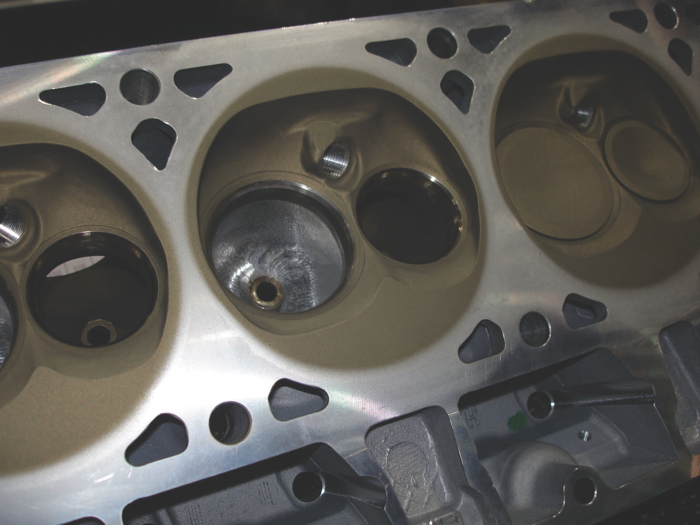
Design Variables in Optimizing Airflow
What determines airflow through a given set of cylinder heads? All of the following play a role:
• The location, profile, shape and volume of the intake and exhaust ports.
• The contour of the “short side” of the intake runners as the ports curve just above the intake valves.
• The height of the intake runners relative to the position of the intake valves.
• The shape and volume of the bowl area just above the valves.
• The size of the valve guides and guide supports in the intake runners.
• The diameter of the valve stems.
• The size of the intake and exhaust valves.
• The angles on the valve seats.
• The angle of the valves in the cylinder head with respect to the deck surface and each other.
• The relationship between the diameter of the valves, the size of the ports, and the diameter of the cylinder bores.
• The size and shape of the combustion chambers and how much shrouding is around the valves.
• The surface finish and texture inside the ports (a slightly rough finish actually flows better than mirror smooth).
• The length and design of the intake runners in the intake manifold.
• The size and design of the intake plenum.
• The diameter and length of the exhaust headers and collectors.
All of these variables influence airflow through the cylinder heads. With most “bolt-on” cylinder heads that have the same basic dimensions and configuration of the original equipment casting, there are physical limits as to how much the ports, valves and combustion chambers can be modified. Ports can be smoothed and blended to improve flow, matched to the intake manifold and enlarged to handle more volume. But sooner or later you run out of metal to remove so there is a limit as to what can be accomplished with porting stock castings. Raise the ports and you’ll likely require a custom intake manifold.
With custom aftermarket castings or CNC billet heads, there’s far more leeway in relocating ports and valves to improve airflow and performance. When combined with aftermarket blocks that have wider cylinder bore spacing, it opens up even more possibilities for improvement.
If you look at many late model overhead cam multi-valve engines, the intake ports tend to be much higher and straighter than those on a traditional pushrod V8. Raising the intake ports gives the incoming air stream a more direct route to the intake valves for better airflow and performance. Going with an overhead cam design also eliminates the need for pushrods that can interfere with port dimensions and locations.
There are a couple of bottlenecks in a traditional pushrod V8 cylinder head that hinder airflow. The intake ports usually make a sharp turn just above the intake valves. The “short side” of the port can cause the air/fuel mixture to separate as it tries to round the tight curve just above the valves. Head porters usually reshape this area make for a smoother transition and increased flow. The location of the pushrods, head bolts and cooling jackets in the head casting can also limit what can be done with the ports to improve airflow.
Reducing Valve Angles
On most gasoline V8 engines, the valves are slanted at an angle to the deck surface of the head (example: 23 degrees in SB Chevy heads and 24 degrees in BB Chevy heads). This is done to accommodate the geometry of the valvetrain that actuates the valves, and to improve airflow with the stock location of the intake and exhaust ports.
Long ago racers discovered that reducing the valve angle often produces better airflow and performance. That’s why aftermarket head suppliers offer a wide range of heads with shallower valve angles (21 degrees, 18 degrees, 15, degrees, 12 degrees, 10 degrees, etc.). That’s also why Chevy went to shallower valve angles in the LS series heads (12 and 15 degrees).
As a rule, decreasing the valve angle usually requires raising the height of the ports to maintain a good relationship between valve angle and port height (but there are exceptions). Cylinder heads with shallower valve angles and raised ports will usually (but not always) outperform heads with stock valve angles and port heights.
The Diesel Difference
With diesel heads, it’s a somewhat different story. Diesel engines are low RPM, high torque engines with high compression. Most diesel engines are turbocharged so cylinder head port design has much less impact on airflow than boost pressure. If you want more power out of a diesel, you just dial up the boost pressure. It’s much easier to push more air through a small port with boost pressure than it is to suck air through a port with a naturally aspirated engine.
Most light and heavy-duty diesel engines have flat valve angles (the valves are straight up with respect to the deck surface of the head) and relatively small ports. The head design provides good airflow and velocity at low rpm for good torque output but generally does not flow well at higher than stock RPMs.
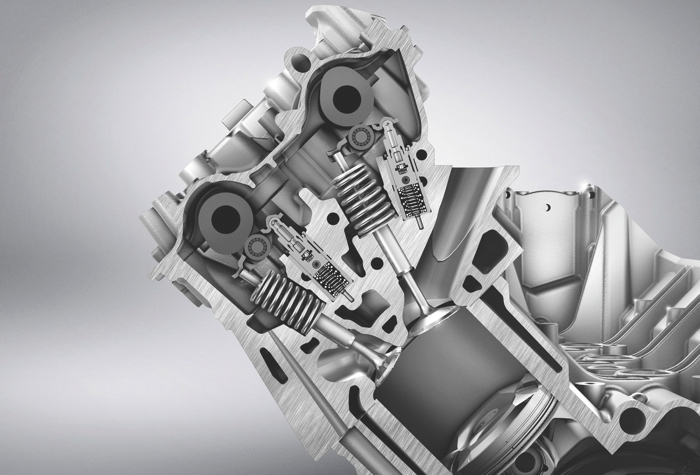
With a truck or tractor pull motor, the engine is often modified to run much higher boost pressures and RPMs. The stock heads can be hand or CNC ported to increase airflow somewhat, or they can be replaced with aftermarket heads (if available) that have larger port volumes. To date, there are few aftermarket performance castings available for light-duty diesel engines, and for the big displacement heavy-duty engines the only options for upgrading are to port a stock casting or have a custom CNC billet race head made.
Sealing a high-pressure diesel head can also be a challenge. With extreme boost pressures, there’s a lot of lifting force trying to push the head away form the block. The head and block deck surfaces have to be smooth and flat to maintain a good seal under these conditions, and a copper head gasket and O-rings may be required to contain combustion pressures. Aftermarket high-strength head bolts are also a must to prevent head gasket failure.
Seeking Guidance
So how do you pick a set of heads that will deliver the most bang for the buck and help an engine achieve its maximum performance potential?
The best advice we can offer is to talk to several head suppliers and ask them for their recommendations. They know their heads better than you do, and they have invested considerable time and effort into developing their heads for specific applications. They can help you sort out the details to determine which head will deliver the best all-round performance for your engine project.
Most of the head suppliers we interviewed for this article said it’s important to keep your expectations realistic. A lot of people would love to have a 1,000 horsepower motor in their street car for bragging rights, but do they really need that much power? It’s certainly possible, but would such an engine be drivable? A more realistic approach would be to build an engine with a somewhat lower power output that generates stump-pulling torque and neck snapping throttle response.
To determine the best cylinder heads for a given application, a head supplier should ask you the following:
• What is the intended use of the vehicle (street, street/strip, drag, circle track, road race, off-road, pulling, etc.)?
• What kind of engine are you building (BB/SB Chevy, Ford, Chrysler, Pontiac, stock block or aftermarket block)?
• Engine displacement (bore and stroke)?
• If it’s a race motor, what do the rules prohibit or allow?
• What kind of fuel (pump gas, race gas or alcohol)?
• Compression ratio?
• Cam specs (roller or flat tappet, hydraulic or solid, valve lift, duration, RPM range)?
• What kind of valvetrain (stock rockers, roller rockers or some type of aftermarket shaft system)?
• Naturally aspirated or boosted?
• Type of transmission (manual or automatic, and the stall speed of the torque converter)?
• Final axle drive ratio?
• Vehicle weight?
They may ask how much money you or your customer is willing to invest in a set of heads. Budget restraints can narrow your range of options rather quickly. Once all of these questions have been answered, there may be additional points to consider before making your selection.
Do you want less expensive cast iron heads or aluminum heads? Cast iron heads are 25 to 30 pounds heavier than aluminum heads but retain heat better than aluminum and are often better for street applications. A performance aftermarket cast iron head may also be a better option than a stock replacement head or ported stock head.
Aluminum heads save weight and are easier to repair if they are damaged than cast iron heads, and they can also handle higher compression ratios with less risk of detonation.
Do you want heads with “as cast” ports or CNC ports? A head with well-designed ports will deliver the same performance whether the ports are as-cast or CNC machined. It’s the shape and flow characteristics of the port that count, not how it is manufactured.
If you or your customer has deep pockets, a set of custom made CNC billet race heads may be the hot ticket to the winner’s circle. Custom heads can be very expensive depending on how much development work and machining is required. It’s not unusual for custom CNC billet heads to cost $10,000 to $20,000 or more, which puts them beyond the reach of many racers and hobbyists. But for $1,000 to $2,000 you can usually buy a good set of assembled aftermarket performance heads for most V8s.
That’s what gets you “ahead.”











